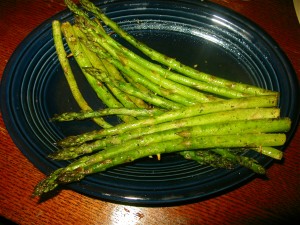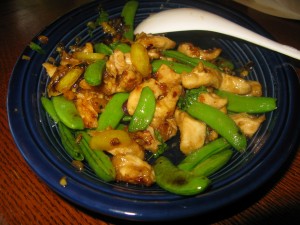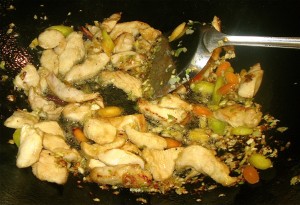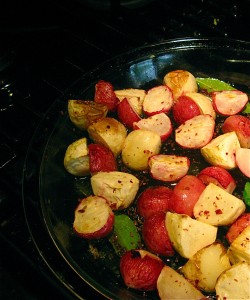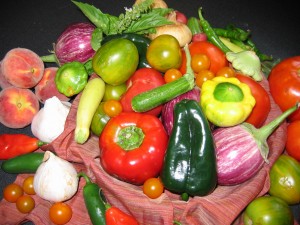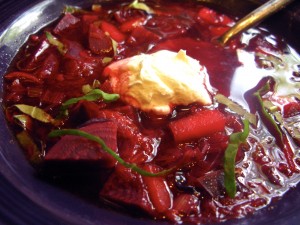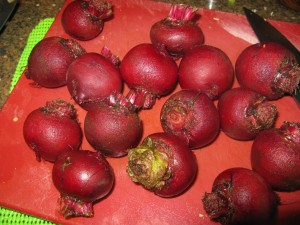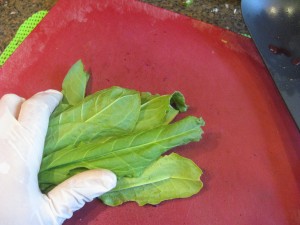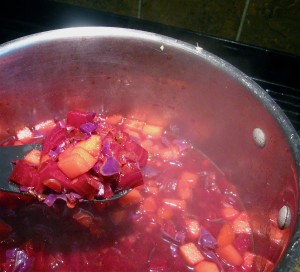Grilling Asparagus
So, I’ve been quiet recently, and that means I have lots of great recipes to share because I did cook while I was quiet, but didn’t write them down. So, a flurry of recipes will be coming your way in the next few days. (By the way, the quiet is because I had a bad cold with a cough that morphed into a really horrible ear infection. So bad I woke up every night with enough pain that I had to get up and take pain killers and wait for them to work before heading back to bed. So, I was awake enough to cook, but not awake enough to write about cooking, because really, the blogging is the hard part.)
Anyway, this isn’t so much a recipe as a technique with ideas for seasoning.
This spring, Zak and I worked on getting grilled asparagus right.
Last year, we put big spears of blanched asparagus on the grill, but never got a great result. Often it was overcooked–in large part because taking the time to turn each of the spears with tongs took forever and a day. And a couple of spears were lost between the grates of the grill, sacrificed to the fire god, and this made Zak howl in primal sorrow and pain each time because he was loathe to loose one morsel of sweet, delicious fresh asparagus.
This year, Zak picked up a grill pan and used raw thin spears of asparagus which he just turned in groups with a spatula, all willy nilly and that would have worked well enough except he found that it was really easy to overcook even unblanched thin spears on the grill.
Back to the drawing board we went, although this time, before either of us could screw up more asparagus, here was an intervention by Chef Steve Raichlen. And not in book form this time.
By chance, we happened to be watching PBS rather idly one rainy and cold Saturday, (there were lots of those this spring) when Primal Grill came on. Kat adores cooking shows (much like Morganna before her who was enchanted by Madeline Kammen and loved Martin Yan when she was three and four respectively), and its about grilling, so I figured we’d watch. Zak even got sucked in, and we learned how to cook shrimp on the grill (which is useless information to me since I am, alas, allergic to the delicious seabugs now), and then, lo and behold, Steve showed us how to grill asparagus.
He showed a neat trick where he threaded four or five fat daddy spears of raw asparagus that were cut to all the same length on long round toothpicks, then marinated them and put them on the grill. They were so easy to turn all stuck together in a row like that, and baste, and put on and take off the grill–it was such a good idea.
So, we tried that and voila! Steve just did not let us down–we managed to perfect grilled asparagus at our house. And once you know how to do it it’s the essence of easy.
All you do is make a sauce/marinade that includes a fat and either an acid, sweet and/or salty component, preferably all three.
You either soak your uniformly cut and skewered asparagus in said sauce/marinade for ten minutes or you brush it on just a few minutes before cooking, and then, you put it on a pre-heated charcoal fire grill that has soaked wood chips to make smoke and cook it, turning once, for two to four minutes.
That’s all there is, folks.
And here you thought making those pretty little asparagus rafts was just a gimmick because they looked all cute and everything. Nope, they’re actually practical because you can just lift each raft with tongs and whup them over on the grill as fast as a duck diving after a June bug.
Here are some ideas for seasoning sauces and marinades. The first one was inspired by Raichlen’s original recipe, while the rest were all me.
Sesame. Honey and Soy Sauce
Doesn’t that just sound great? To one tablespoon of each of toasted sesame oil and honey, add 2 tablesppoons of tamari soy sauce and a pinch of Aleppo pepper or whatever other crushed chili flakes you like. Sinfully simple.
Ghee with cumin seeds, mustard seeds and lemon juice.
This is just what it says–a tablespoon of melted ghee with pan-toasted cumin and mustard seeds–about 1/2 teaspoon each and 1 tablespoon of freshly squeezed lemon juice.
Finally, what about olive oil, balsamic vinegar, freshly minced basil, sea salt and minced fresh garlic?
This is a delicious way to turn any plain vegetable into a wanton temptress. Brush on equal parts oil and vinegar, and sprinkle with basil sea salt and freshly minced garlic on both sides of the “raft.”
And grill.
And then, eat.
And enjoy.
That last part shouldn’t be too hard, should it?
Unless, of course, you’re unfortunately allergic to potatoes. (That’s even worse than becoming allergic to shrimp in your old age….)
Honeyed Chicken with Snap Peas and Carrots
Aren’t those snap peas just the prettiest things?
Those sweet green goodies have been driving me mad for three days because they’ve been in my crisper drawer, waiting, waiting, WAITING for me to cook them, and I haven’t been able to, but I’ve wanted to for just days and days.
See, I’ve had an ear infection and for the past three days before today, it had gotten bad enough to affect my sense of balance. And Zak made the command decision that a Barbara who pitches and yaws about like a lumbering, drunken ox is unsafe to be holding anything resembling a sharp knife or cleaver and even more unsafe to be around fire and a cast iron wok.
But, I had a doctor’s appointment today and I am pleased to say that with the first dose of antibiotic, bacteria were mowed down ruthlessly such that the pressure in my ear and sinuses lessened to the point that I can stand up and walk a straight, or mostly straight line. The first thing I decided to do was get in that kitchen and prep to cook up those delicious snap peas I got from the Farmer’s Market that I’ve been dreaming about for days!
They were still crisp and brilliant peridot green when I popped them on the counter and stringed them. And they smelled just like springtime ought to smell–fresh and verdant. I scrubbed baby carrots in shades of orange, yellow and violet and sliced them diagonally to go with the peas, and the colors were all so pretty it was hard not to just gobble everything up raw.
But considering how much Kat ate at dinner, I’m glad I didn’t snarf up all of the veggies myself. She ate her entire bowl of rice, chicken, peas and carrots and asked for more, all without any prompting from Mom or Dad. For those with four year old kids, you know what a victory that is! She even asked if she could have the leftovers for lunch at school tomorrow (that would be today), and she hardly ever does that…..
Anyway, this is just a simple stir-fried dish with clean, fresh flavors that enhance rather than cover the natural flavors of the chicken, peas and carrots. I used a small amount of fresh garlic, more ginger and fresh scallions as aromatics, and the flavorings were soy sauce, honey, sesame oil and mirin.
Mirin is a rice wine from Japan that is light and sweet, much more subtle and flowery in flavor than Shao Hsing wine, which is the Chinese rice wine I usually favor. I happened to have some and decided to use it and was pleased at how seamlessly it melded with the honey and light soy sauce flavors.
This is not a dry dish, but what sauce there is clings to the vegetables and chicken and does not pool on the serving plate. There is enough to flavor the rice in your bowl, but not so much that it is drippy or gooey.
The soy sauce I used in this dish is almost locally made–it’s from Kentucky, and is brewed in a Japanese style, using old bourbon barrels as fermentation vessels, so it has a distinctive smokey aftertaste. Bourbon Barrel Foods makes a mighty fine soy sauce, and is well worth seeking out and trying. It has a clean refreshing flavor with that wonderful smoky finish that I just love, and is perfect to use when you want your food to just taste oomphier and better, not soy-saucey. (Their smoked paprika is awesome as well.)
Besides, I get a kick out of using soy sauce made in Kentucky. It just makes me smile, because you don’t think Kentucky and see visions of soy sauce dancing in your head, do you? I know I don’t.
(Same as I don’t think of West Virginia and instantly muse on about tofu, but you know, the best tofu I’ve ever had, Spring Creek, is made in Spencer West Virginia, from soybeans grown here in SE Ohio, one county away from where I live. Now that I think on it, Appalachia has some mighty fine artisanal Asian foods being made in the sheltering arms of her mountains and hollers.)
But, I digress.
What was I talking about again? Oh, yes–the snap peas and the chicken dish. Right.
I was talking about the flavorings in it–right? Well, the honey is from right here in Athens County–Cantrell’s. Jack Cantrell is a great beekeeper and his honey is wonderful and I think it’s the reason why my nose hasn’t fallen off this year from the allergies. Pollen is horrible this year–the air is yellow with it, and usually when its that bad, I have two or three asthma attacks at least, but since I’ve been having a spoonful of the local honey a day, it seems to have helped me build up enough immunity to it that I can at least go outside and breathe with impunity. And, you know, honey sure tastes better than Benedryl!
And the sesame oil is the final flavoring ingredient–always be sure and use the toasted sesame oil for the best flavor and add it at the end of cooking so it stays fresh tasting and doesn’t scorch.
At any rate, here is the recipe for the dish that Kat not only ate all of her portion of, but which made our house smell so good that when we came back from seeing Kung Fu Panda 2 at the theatre, it was like stepping into Po’s Dad’s noodle shop!
Oh, and the movie was great fun, by the way, and the use of 3D was much more subtle and beautiful than I expected. (I usually am unimpressed by 3D anything.)
Honeyed Chicken with Snap Peas and Carrots
Ingredients:
1 medium boneless skinless chicken breast, cut into 1″X1/4″x1/2″ strips
1 teaspoon honey
2 tablespoons mirin or pale rice wine
2 tablespoons thin or light or Japanese style soy sauce
3 tablespoons cornstarch
3 tablespoons canola or peanut oil
1 clove garlic, peeled and minced
3 scallions, trimmed and white parts and light green parts minced
2″ cube fresh ginger, peeled and minced
5 baby carrots, scrubbed and cut on the bias into 1/8″ thick oval slices (use multicolored carrots if you can get them)
1 tablespoon light soy sauce
1 teaspoon honey
2 tablespoons mirin or light rice wine
8 ounces snap peas, stringed
1 tablespoon fresh lemon juice
1 teaspoon toasted sesame oil
1/4 cup cilantro leaves, picked off the stems
Method:
Toss chicken with next four ingredients and allow to marinate while you prepare the rest of the ingredients–about 20 minutes.
Heat wok over high heat until a thin ribbon of smoke rises from the heated metal surface. Add the canola or peanut oil and swirl wok to coat bottom. Allow to heat for about thirty seconds or until you can see the surface of the oil shimmer and move with convection currents.
Add the chicken, reserving any marinade that is not clinging to the meat. Spread the chicken out into a single layer on the bottom of the wok and sprinkle the garlic, scallion and ginger over the top of the chicken.
Allow the chicken to sit undisturbed on the bottom of the wok to brown for at least a minute. THEN and only then begin to stir fry, stirring constantly to keep the chicken and the aromatics from sticking.
When the chicken is mostly done–very little pink is showing–it is mostly brown and white–add the carrots, and the second measures of soy sauce, honey and mirin and keep cooking and stirring for another thirty seconds or so. Add the peas, and cook, stirring, until the chicken is done and the peas have taken on a bit of brownish color from the hot wok.
Add the lemon juice, stir it in thoroughly, remove from heat and stir in the sesame oil and cilantro.
Scrape onto a heated platter and serve right away with steamed jasmine rice.
Add
Roasted Radishes and Turnips with Ghee, Cumin and Mustard Seed
This recipe was an experiment, and to my taste, if I was going to do it again, I would do it all with turnips, and leave the radishes for another day.
But those red radishes in the picture sure do look pretty sprinkled in with the white turnips, don’t they? But, there was something about the way the radish earthiness synergized with the curry leaves, cumin seeds and especially mustard seeds that was a little too piquant for my taste, though the sweet turnips cooked this way were velvety and utterly fabulous.
So, it’s your call–if you try the recipe, you can choose to do it with all turnips as I will next time (because I liked the turnips enough that there will be a next time!) or you can give the radishes a try and see if you like them more than me.
It got the idea for roasting radishes from a recipe I read on Kalyn’s Kitchen, where she used soy sauce and sesame seeds to roast her radishes. I decided I wanted to try roasting radishes with Indian flavors instead, hence the ghee, cumin, mustard and curry leaves–but I think I’m going to have to try again and stick closer to her original recipe. Because I loved my stir-fried radishes that had soy sauce and sesame oil involved in them so I think Kalyn’s recipe just can’t go wrong.
But, that’s okay–cooking is not precise, and to cook creatively, sometimes you have to go out and a limb and sometimes that limb cracks and you fall out of the tree of culinary novelty and fall right down on your ass. But, even as you stand up and dust off your bruised tuckus, you have to admit that you learned something.
What did I learn here?
That I like turnips roasted with ghee, cumin and mustard seeds and radishes not so much. AND, I learned that Kalyn’s recipe with the soy sauce and sesame was probably a better way to go with the radishes, so I have another recipe to try next time.
So, here is my little culinary experiment–I hope you like it, though I really suggest you make it with all turnips instead of half turnips and half radishes like I did. I think you will like it better.
Roasted Turnips (and Radishes) with Ghee, Cumin and Mustard Seed
Ingredients:
1/2 pound baby turnips (or 1/2 turnips, 1/2 radishes) about the size of a golf ball
1 1/2 tablespoons ghee, melted
salt to taste
3 fresh curry leaves, lightly bruised
1/2 teaspoon cumin seeds
1/4 teaspoon mustard seeds
pinch Aleppo pepper
Method:
Preheat your oven to 400 degrees F. Trim tops and bottoms of turnips and scrub well, removing any root hairs as you go. Cut into quarters.
Pat dry with paper towels or woven cotton kitchen towels. Drizzle bottom of a baking pan that will fit your turnips in a single layer with the melted ghee and put the turnips in the pan. Toss to coat well with ghee. Sprinkle with salt.
Put into oven and roast for about 15 minutes, turning and stirring once or twice. When the turnips have started to brown on the edges but are still not quite fork tender (meaning that you can put a fork into the vegetable with a bit of resistance, but it will not easily slide off the fork), add the curry leaves, cumin and mustard seeds to the ghee on the bottom of the pan.
Return to the oven and continue roasting until the turnips are fully tender, meaning that they can be easily pierced by a fork and will slide easily off of the tines, about five minutes more.
Remove from oven and toss well to coat with the spices and the now flavored ghee.
Taste for salt and adjust as necessary and sprinkle Aleppo pepper flakes over the turnips as a garnish.
The Sticky Issue of Food Sovereignty : An Old Locavore Speaks Up
There’s a new bit of locavore lingo on the scene: “food sovereignty.”
What it refers to is the ability of individuals to safely sell and buy locally produced foods such as raw milk, or farm-slaughtered meats without having to fear prosecution for violating federal or state laws regulating such foods.
Two communities in New England have passed by voter referendum statues declaring the rights of consumers and producers to buy and sell local food products without having to adhere to any state or federal regulation regarding these items.
The first community, the town of Sedgewick, Maine, passed the “Local Food and Community Self-Governance Ordinance” which effectively allows local consumers and farmers or other local food producers to enter into private agreements and transactions which effectively override federal and state health codes, bans, food safety laws and regulations governing food production. The ordinance also notes that the individual is required to do his or her own research into the safety of consuming raw products such as dairy, meat, vegetables and eggs.
In other words, caveat emptor–the buyer must shoulder the burden of understanding the possible health consequences of eating the food they are buying from their hopefully trustworthy farmer/neighbors.
The towns of Penobscott and Blue Hill, Maine later followed suit by passing similar legislation.
Barre Town, Vermont passed a similar measure by voter referendum (673 votes for and 200 against) which “reject federal decrees, statutes, regulations, or corporate practices that threaten our basic human right to save seed, grow, process, consume, and exchange food and farm products within the State of Vermont.”
The Vermont measure was in part a response to the threat from Monsanto to local seed-saving farmers whose crops had mingled with the corporation’s GMO seed, as well as a push back against a short-lived ban on the teaching of raw-milk cheesemaking. (Vermont’s Governor Shumlen signed The Dairy Class act into law, which allowed the raw cheesemaking classes to continue.)
The wording of both the Vermont and Maine laws are wide-reaching and on a shallow reading of them unable to withstand a legal challenge on a state or federal level.
However, if one looks more deeply at the Maine Constitution, there is a strong provision for “Home Rule” which allows local municipalities self-governance on community issues, which many say should include food sovereignty.
On the other hand, two bills which would support the local ordinances passed in Maine, one involving the sale of dairy products from small farmers directly to consumers, both were defeated in the House of Representatives recently.
This is a contentious issue, and one that I, myself, find difficult.
On the one hand, I understand that historically, our federal and state laws involving food safety regulation were originally put into place in good faith to protect the consumer from unscrupulous food producers who adulterated their products, (such as watering down milk or adding chalk to it) or engaged in unsafe slaughtering practices (such as were outlined in Upton Sinclair’s The Jungle. These laws were at one time, good and just, and truly had the well-being of the consumer in mind. And currently, those laws still nominally protect consumers from unsafe food production, though truthfully, looking at all the corporate food recalls and foodborne illness outbreaks across our country, one must note that they are doing a pretty poor job of protecting consumers.
However, those same laws have since morphed into protections for corporate and industrial food producers, by insisting that smaller family farms and food producers adhere to the same sanitation rules that govern the huge agribusinesses that dominate the landscape. In doing so, these laws are effectively pushing smaller producers out of business, because the regulations no longer recognize that smaller operations can be cleaner and more safe for workers and consumers by using different methods more applicable to small productions. Forcing small producers to use the same equipment as large producers creates an onerous financial burden for the small farmers, which essentially forces them out of business, allowing the larger corporations to sell their products with no local competition.
Which sounds rather like government-supported racketeering to me.
So, what do I think of all of this?
I think that the essential idea of local food sovereignty is a good one, but I also believe that communities must tread carefully in their pursuit of it. I think that it is perhaps too sweeping to throw out all food safety regulations, on the other hand, I believe that the fight against corporate control of our food supply is not only just, but necessary.
My very first reaction to the ordinances as they were presented on blogs was a knee-jerk, “Well, that’s a dumb idea,” but since carefully reading other sources of information, I have revised my position. It should be a fundamental human right to personally determine where and how we obtain our food, and there is no need for governments essentially force humans to stop farming on a small scale in preference to farming on a corporate scale.
For our federal government to do so goes against the very spirit of our Constitution and Bill of Rights, and I, personally will fight against such actions every step of the way, until I have expelled the last breath from my body. I was born of a line of small farmers and butchers who made their livings producing food for their families and others, and I am proud of that heritage, and I stand with those whose livings are made the way my forefathers and foremothers were.
We Got The Beets: Ginger-Kissed Borscht
Yeah, we got the beets!
Sorry, that old Go-Gos song gets stuck in my head, especially when I’m scrubbing a couple of pounds of beets to make borscht. See, I never peel my beets–lots of the nutrients are right under the skin, and besides, they are a pain in the tuckus to peel, so I just scrub the daylights out of them with a vegetable brush under cold running water. And invariably, while I’m scrubbing, a tinny, ghostly sound ripples through my psyche, slithering through my neurons, wending its serpentine way through the halls of my high school memories before gripping my cerebrum tightly in its manicured talons, shaking it and refusing to let go.
It’s the unforgettable opening drum solo joined by the driving guitar riff, then finally, Belinda Carlisle’s vocals, and dammit–there it is again, and it’s stuck in my head for at least the rest of the day. “We Got the Beat” is then going to play over and over on Barbara’s Brain Radio station accompanied by visuals of bouncing magenta root vegetables dressed in glitter and go go boots until displaced by another, equally annoyingly catchy tune, such as Leonard Nimoy’s “The Ballad of Bilbo Baggins.”
And now that I’ve mentioned the dreaded song, “The Ballad of Bilbo Baggins,” can anyone tell me just how high Nimoy was when he recorded not just the song, but the video? I mean, Nimoy was always ahead of his time and all, but why record a video when MTV hadn’t even been invented yet? And, why -THAT- video? Don’t get me wrong, I me some Leonard Nimoy, not just because he gave the world my beloved Spock who was my role model during my troubled teen years, but also because he’s a talented poet, artist and director and a really cool guy, but Bilbo? Really?
Alas, I digress.
We were talking about beets, not hobbits.
Beets. I don’t hate them anymore, in fact, I rather like them. When I was a child, I only valued them because they dyed my hands pink and they were a pretty color, but I wouldn’t eat them even if I was paid to do it. Now, I like them because they are a gorgeous color, and I love the taste and smell of them, but I’m not so into pink hands, so I wear latex gloves when handling them. I guess I’ve grown up a bit, eh? Oh, well.
But, I have to say, remembering my childhood fascination with the color of beets is useful, because I used that knowledge to get Kat to taste them. I told her she could use a piece of roasted beet to tint her lips pink, like lipstick. She did it! Then I had her lick her lips and she liked the way they tasted, so she tasted the beet and then–ATE IT! Ha ha! Point one for the clever Mommy who remembered how important things like colors are in childhood! And–she liked it! Because I told her it was sweet–which it was–and didn’t tell her that only grownups liked beets–which is what my mother told me when I was little. (Self-fulfilling prophesy there.)
Beets are now on the menu at my house, and usually, I serve them roasted, because that’s how all of us like them, but sometimes I get a craving for a good bowl of steaming hot borscht. (Unless its summer, and then I want it cold.) In the winter, I like it with beef or sausage in it, but in the spring and summer, I prefer it made vegetarian, though not vegan, because to eat it without a good dollop of Greek yogurt in the middle is like seeing Dolly Parton without sequins. It’s just as pretty and sweet, but something is missing and that’s the glitz that makes it all so special.
Now last week, when I made this borscht, I had an awful cold. Terrible. I won’t describe all of the soggy details, but let it suffice to say that my sense of smell was a bit off and my throat hurt like the dickens and i desperately wanted something warm, comforting and tasty soothe the savage tonsils and make my cold innards thaw out. And so, I had all these beets, and some pretty red cabbage and some Gold Rush apples, all local, in the fridge and I thought–aha! Borscht! But then I got sad because the flavors of borscht are pretty mild, and without a lot of flavor, any soup was going to taste like lumpy hot water to my virus-deadened senses. No fun.
But then, I thought to myself, “Why not add fresh ginger to the soup? And star anise, and maybe a bit of cinnamon and fennel?” After digging in the fridge, I came up with a stalk of lemongrass. A plan began to formulate in my head and I slogged off to the computer to check a vague memory I had of a Chinese version of borscht.
I was right. I -had- remembered reading about a Chinese variant of borscht, though it is made with tomatoes and not beets. Or red cabbage and no beets. Apparently, it is popular in the northern city of Harbin, and the direct translation of its name is, “red soup.” It is also known in Hong Kong as well.
But, I had beets, and I didn’t want to use beef, so I decided to make up my own version of Borscht with Chinese spices and flavorings and to heck with what’s traditional anywhere else in the world.
So, I did.
And, I’m glad I did, because this is my favorite version of borscht yet.
The Chinese flavorings melded perfectly with the sweet earthiness of the beets and the tang of the lemon juice. The apples took to the spices readily and the perfume of lemongrass made a light, floral note that made the soup taste like the essence of springtime.
A final fresh note graced the soup in the form of the chiffonade of fresh sorrel leaves I sprinkled over the top as a garnish. Sorrel isn’t as commonly grown in the US as it should be–it’s a light, brightly flavored garden green whose broad, long leaves are tangy with oxalic acid, which in small amounts is harmless to beneficial–in large amounts it is poisonous and can be fatal. However, it is widely used in European cuisines–sorrel soup is a famous green pureed soup in France, and in Greece, it is used with spinach, mint and other wild greens in spanakopita, which is a delectable phyllo dough triangle-shaped pastry with cheese.
This is a very tasty soup and very quick and easy to make for a good spring lunch or first course for dinner. It is filled with vegetative goodness: garlic leeks (or leeks) celery, carrots, beets, apples and cabbage, and has lots of aromatics to help make everything taste like a sunny spring day: fresh ginger, lemongrass, star anise, cinnamon, fennel seeds, lemon juice and sorrel.
This soup also freezes well, and is good to have around in case a cold or a beet emergency–meaning–a sudden middle of the night craving for beets. I’m sure it happens to someone, though maybe not as often as a chocolate doughnut or cheesecake emergency.
Ginger-Kissed Borscht
Ingredients:
3 garlic leeks or regular leeks (if using regular leeks, add 3 cloves of garlic, minced to the recipe)
2 tablespoons olive oil
3 stalks of celery, sliced thinly
3 carrots, peeled or scrubbed well and thinly sliced
2 ” cube fresh ginger, peeled and minced
1 stalk lemongrass, lower third only, crushed lightly
1 star anise
1″ piece cinnamon stick
1/4 teaspoon fennel seeds, ground (I did mine fresh in the mortar and pestle)
2 quarts vegetable broth or stock
1 heaping tablespoon honey
2 1/2 pounds red beets, well scrubbed, tops and bottoms trimmed away
2 tart apples
2 cups finely shredded red cabbage (use a knife to shred into thin strips–like chiffonade)
Juice of 1 or 2 large lemons–to taste
1″ cube fresh ginger peeled and grated– add to taste
salt to taste
pepper to taste
fresh sorrel or parsley for garnish
Greek yogurt for serving
Method:
Cut the coarse, dark green leaves from the tops of the garlic leeks and discard (in the compost pile, preferably.) Slice the garlic leeks longitudinally in half and rinse well under cold water, using your fingers to work under all the layers of the vegetable. Dry well on paper towels or cotton woven towels. Slice thinly after they are dry.
Over a medium fire, heat olive oil in a heavy-bottomed soup pot and add garlic leeks (or leeks and minced garlic), celery, carrots and ginger, and cook, stirring, until the leeks and celery take on a golden coloration and all is very fragrant. Add the lemongrass stalk, star anise, cinnamon, and fennel and cook, stirring for one more minute.
Add vegetable broth and honey and bring to a simmer.
Dice the beets into a fine, but not tiny dice–about 1/2″ on all sides, and add to the pot. Peel the apples and add them when the beets are halfway cooked. After shredding the cabbage, cut the shreds into 1″ lengths and add to the soup after the beets are done. During the cooking, add water or more broth if necessary.
Simmer for 1/2 hour more after the beets are fully tender. Turn off heat, add lemon juice, freshly grated ginger, salt and pepper to taste.
Sprinkle each bowl with chiffonade cut sorrel leaves or minced parsley leaves, and pass Greek yogurt for each diner to add to their own taste.
Powered by WordPress. Graphics by Zak Kramer.
Design update by Daniel Trout.
Entries and comments feeds.

